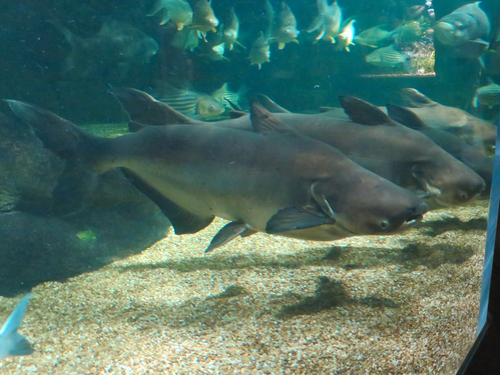
Mekong giant catfish
The Bluefin Tuna (Thunnus thynnus, Thunnus orientalis, Thunnus maccoyii) is a highly migratory, pelagic fish renowned for its size, speed, and commercial value. This magnificent species plays a crucial role in marine ecosystems and is a prized catch in fisheries worldwide.
20 60 years
Lifespan
300 cm
Length
Critically Endangered
Conservation Status
10 km/h
Swimming speed
Herbivorous
Diet
Local Migration
Migration
Appearance Overview
The Bluefin Tuna is renowned for its large, streamlined body, built for speed and endurance.
Color
Dark metallic blue on top, with a silvery underside
Fins
Two dorsal fins, the first depressible; small, yellow finlets run down the back and belly towards the tail
Body Shape
Torpedo-shaped, facilitating swift movement through water
Length
Up to 10 feet (3 meters), commonly 6.5 feet (2 meters)
Weight
Up to 1,500 lbs (680 kg), commonly around 550 lbs (250 kg)
Diet
Carnivorous, feeding on a variety of fish, squid, crustaceans, and occasionally, zooplankton and algae.
Feeding Behavior
Highly active predator, using its speed and agility to hunt. Often feeds cooperatively, herding prey fish into tighter formations.
Social Behavior
Forms large schools, sometimes segregated by size. Known for long migrations across oceans.
Commercial Relevance
Extremely high value, especially in sushi and sashimi markets, where its fatty flesh is a delicacy.
Conservation measures
International fishing quotas, catch limits, and monitoring programs. Efforts to establish marine protected areas and promote sustainable fishing practices.
Status
Varies by species: Atlantic Bluefin - Endangered; Southern Bluefin - Critically Endangered; Pacific Bluefin - Vulnerable
Threats
Overfishing is the primary threat. Other factors include bycatch in other fisheries, climate change affecting prey distribution, and habitat degradation.
Habitat Distribution
Depth Range
0-1,000 meters (0-3,280 feet), typically found in surface waters but capable of deep dives.
Geographic Range
Atlantic Ocean (from Newfoundland to the Mediterranean Sea), Pacific Ocean (from Japan to California), and Southern Ocean (around Australia and New Zealand)
Preferred Environment
Temperate and subtropical waters; highly migratory, often following warm ocean currents.
Reproduction and Life Cycle
Breeding Habits
Spawns in specific areas, such as the Gulf of Mexico and the Mediterranean Sea, where warm water temperatures are favorable. Spawning typically occurs during specific seasons.
Development Stages
Eggs hatch into larvae, which feed and grow rapidly in plankton-rich waters. Juveniles form schools and gradually develop the characteristics of adult tuna.
Fecundity
Females can produce up to 10 million eggs per spawning season, releasing them into the water column for external fertilization.
Maturity Age
Atlantic Bluefin: 4-8 years; Southern Bluefin: 8-12 years; Pacific Bluefin: 3-5 years
Faqs about Mekong giant catfish
How fast can Bluefin Tuna swim?
Bluefin tuna are among the fastest fish in the ocean, capable of bursts of speed up to 43 mph (70 km/h).
What is the lifespan of a Bluefin Tuna?
Bluefin tuna can live up to 40 years, although this is rare due to fishing pressure. Many reach 15-20 years.
Where are Bluefin Tuna found?
They are found in the Atlantic, Pacific, and Indian Oceans, including the Mediterranean Sea. They are highly migratory, often crossing entire oceans.
Is it safe to eat Bluefin Tuna?
Yes, but due to overfishing and their endangered status, consumption should be avoided or limited to sustainably certified sources.
Are Bluefin Tuna warm-blooded?
Bluefin tuna are warm-blooded, allowing them to maintain a higher body temperature than the surrounding water, which aids in their speed and endurance.
What is the largest Bluefin Tuna ever caught?
The largest recorded Bluefin Tuna weighed 1,496 lbs (679 kg).
How many eggs do Bluefin Tuna lay?
Female Bluefin Tuna can release millions of eggs per spawning season, but the survival rate of these eggs is very low.
Do Bluefin Tuna migrate?
Yes, Bluefin Tuna are known for their extensive migrations, often traveling thousands of miles between feeding and spawning grounds.
Copyright @ Nature Style Limited. All Rights Reserved.
 English
English